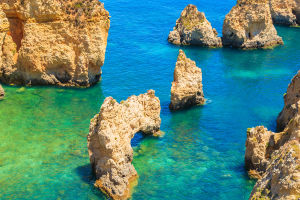Beaches are a haven for relaxation, providing a perfect escape from the bustling city life.
While the rhythmic sound of crashing waves and the gentle touch of sand can be incredibly soothing, some beaches are enhanced by the presence of a breakwater. Acting as nature's shield, breakwaters play a vital role in preserving the coastal landscape and ensuring a safe and enjoyable beach experience. Let's delve into the intricacies of breakwaters, exploring their purpose, design, and environmental significance.
A breakwater is a structure built along the shoreline or within the coastal waters to protect beaches and coastal structures from the erosive forces of waves. They are typically constructed using durable materials such as rock, concrete, or a combination of both. The primary objective of a breakwater is to create a barrier that absorbs, deflects, and dissipates the energy of incoming waves, reducing their impact on the coast.
Breakwaters serve a variety of essential functions, making them a crucial component of coastal management. Firstly, they act as a protective barrier, shielding the shoreline from the full force of waves and preventing erosion. By dissipating wave energy, breakwaters help maintain the stability of beaches, reducing the risk of coastal erosion and preserving the natural beauty of the coastline.
Moreover, breakwaters provide a safe harbor for vessels, protecting them from rough seas and facilitating maritime activities such as fishing, boating, and shipping. They create calm waters within their boundaries, shielding boats and docks from the impacts of high-energy waves.
The design and construction of breakwaters require careful consideration of various factors, including wave climate, sediment transport, and environmental impact. Breakwaters can be categorized into three main types: rubble mound, vertical, and composite.
Rubble mound breakwaters consist of a core made of rock or concrete rubble covered with an outer layer of armor stones. The interlocking arrangement of these stones helps dissipate wave energy. Vertical breakwaters, also known as seawalls or revetments, are vertical structures built to absorb wave energy directly. They are typically made of reinforced concrete or sheet piles. Composite breakwaters combine elements of both rubble mound and vertical structures, offering a hybrid solution that leverages the advantages of each type.
While breakwaters provide numerous benefits, it is important to consider their potential environmental impacts. The construction of breakwaters may alter natural sediment transport patterns, leading to beach erosion or deposition in unintended areas. Additionally, breakwaters can affect coastal habitats, such as seagrass beds and coral reefs, by altering water flow and wave dynamics.
To mitigate these impacts, environmental assessments are conducted before constructing breakwaters. These studies evaluate the potential effects on marine life, sediment movement, and shoreline dynamics. Furthermore, innovative designs, such as permeable breakwaters, are being explored to minimize disruption to natural processes and promote ecological balance.
Breakwaters are essential coastal structures that safeguard beaches, prevent erosion, and provide a safe harbor for vessels. By absorbing and dissipating the energy of waves, breakwaters preserve the natural beauty of coastlines while facilitating various maritime activities. However, their construction must be approached with care to minimize environmental impacts. As we continue to explore sustainable coastal management practices, the development of breakwaters that strike a balance between protection and ecological preservation will play a crucial role in ensuring the long-term health and sustainability of our beaches and coastal ecosystems.


